While the cartridge itself is not the ‘holy grail’ of cartridges, because there are more powerful cartridges available, advances in the cartridge continues to be a calling for the cartridge over others. The mild recoil of the cartridge, even in modern polymer sub-compact pistols, makes it a pleasure to shoot even under rapid fire conditions. Add some weight to the pistol that fires the cartridge, and firing the cartridge is no more obtrusive than firing a .22 LR or .22 WMR cartridges.
In 1975, the CZ75 was introduced and took the pistol community by storm. Many call the CZ75 the first “Wonder Nine” due to its magazine capacity and inherent accuracy. In many ways, I agree with that assessment.
I recently made a statement that rather than owning a 1911-based pistol chambered in 9mm I would rather own a CZ75, which to my thinking, is more in line with the 1911 than many other 9mm pistols. When I was a LEO, I was given the “choice” of not carrying my Colt Series 80 MKIV 1911 and to begin carrying a double-action pistol. I seriously considered the CZ 75, having shot one on a previous occasion, but decided to carry the Sig Sauer P220 because I had a serious investment in things .45 caliber. The CZ 75 had always remained in the hidden recesses of my mind, as I found it a highly desirable pistol, and I have a fondness for all steel handguns. Much later, the CZ 75 became just another item in my long list of ‘bucket list’ firearms.
Recently at my local range, I had the pleasure of shooting a CZ 75B, the second generation of the CZ 75, and the desire to own one of these pistols caused the item on my bucket list to crawl upward toward the top of the list. While I have an appreciation of more modern firearms produced by; Glock, Springfield, Smith & Wesson, Ruger, Berretta, and others I stay remain somewhat ‘old school’ and the CZ 75 falls into that class of firearms in my mind. Think about that ‘old school’ term for a moment. To some, if any pistol came out before the Glock pistol was introduced, the pistol is considered as ‘old school’ and the 1911 is considered as an antique firearm. To those of us who are older and wiser, we know the value of ‘old school’ in most things. So let’s take a look at the ‘old school’ CZ 75B.
The CZ 75B is the second generation CZ 75 and has an internal firing pin safety, squared and serrated trigger guard, and ring hammer. The CZ 75B is a full-size, hand-filling pistol that incorporates a John Browning designed linkless cam locking system. Its accuracy; however, is attributed to the full-length slide rails and how the slide is mated to the frame, which is internal rather than external as with the 1911 and many more modern pistols.
I was faced with a choice of the CZ 75B or the CZ 75 B Ω (Omega), when I encountered both at my LGS.
The CZ 75 B Ω (Omega) is presented in a nice (plastic) box with all the paperwork, trigger lock, extra magazine, and a basic cleaning kit. I thought the cleaning kit was a nice touch. The CZ 75 B Ω (Omega) features a simpler, more robust version of the 75’s trigger system. The interlocking design of the trigger mechanism’s parts allows for easy disassembly and reassembly without the need for tools, so taking the pistol down beyond a basic field strip is much easier than on a standard 75. Not only does this simplify maintenance, the trigger parts themselves are made of different materials, enhancing durability, operation life and reliability.The CZ 75B Ω (Omega), like the CZ 75 and CZ 75B, is a DA/SA pistol that allows for “Condition 1” carry, which is uncommon among DA/SA pistols. Having carried a 1911, and with which I am extremely familiar with “Condition 1” carry, any transition to carrying the CZ 75B Ω (Omega) is non-existent. The frame-mounted thumb safety, like a 1911-based pistol, is pushed downward to an ‘off-safe’ condition. Being new; however, the thumb safety on this particular model takes both thumb to place it in the “safe’ position. The thumb safety may loosen up over time. The CZ 75B Ω (Omega) also incorporates a hammer-block safety to prevent the pistol from firing if dropped.
One key feature, oftentimes overlooked, is that the slide rails are internal to the pistol. The rail system is full-length and adds to the accuracy and durability of the pistol.
The slide lock, just forward of the thumb safety, provides the means to release the slide from its rearward position and chamber a fresh cartridge. It does; however, have one caveat if you have small hands; it cannot be reached with the shooting hand’s thumb without changing your grip position. Of course, I can say the same for most 1911-based pistols. Normally, and when shooting 1911-based pistols, I release the slide by pressing the slide release with the thumb of the support hand. The same is true with the CZ 75B Ω (Omega). Again, if you are familiar with running a 1911-based pistol, the learning curve for operating the CZ 75B Ω (Omega) is extremely short if non-existent. By the way, controls are not ambidextrous.The 4.6-inch barrel places the CZ 75B Ω (Omega) between the “Commander” and “Government” class of pistols and is more than adequate for “duty” use. The grip length; however, may be a deterrent in carrying the CZ 75B concealed (aside from the weight of the pistol). The CZ 75B is, after all, a service pistol. The width of the CZ 75B is 1.4 inches and that may also turn some off from carrying the pistol concealed – although it should not. Comparably, the Glock G19 has a width of 1.18 inches and is more squared off in its profile. The CZ 75B Ω (Omega), on the other hand, has very smooth and rounded lines that aid in concealment. The grip of the gun, as with that of many other pistols, is always a concern for concealed carriers. Again, and comparably, the CZ 785B Ω (Omega) has a magazine capacity of sixteen rounds; whereas, the Glock G19 is a fifteen rounder in stock form. Seventeen round magazines are also available (where legal) for the CZ 75 series of pistols.
There are numerous holsters available for IWB carry (Crossbreed, Alien Gear, and SHTF Gear, for example) and the Bianchi #7/7L for the Beretta 92 is a good choice for OWB carry as it has a thumb break that holds the CZ 75B Ω (Omega) securely and ready for double-action mode operation. The magazine release is located at the left rear of the trigger housing and is well within reach of the thumb of the shooting hand. In fact, the magazine release button is an upgrade to the CZ 75 and CZ7 5B. Ejection and insertion of magazines is positive. Each magazine base extends slightly from the pistol but also ensures a positive insertion of the magazine. Two magazines come with the pistol, but MecGar magazines are available in several capacities (14, 16, and 17 round).The CZ75B Ω (Omega) is not a lightweight. However, let’s put the weight into perspective. The Ruger SR1911CMD A, the lightweight Ruger 1991 “Commander” and my current carry, weighs in at 29.3 ounces dry. The CZ 75B Ω (Omega) weighs in at 27.2 ounces dry. After loading to the maximum capacity, the CZ 75B Ω (Omega) is heavier than my lightweight Ruger. In fact, the Glock G19 is heavier than my Ruger when fully loaded to capacity. The only obvious and significant difference is the number of rounds carried. Weight, then, is not as serious factor to consider as round capacity – or so it would seem. Most folks will lean to the 9mm because of round capacity over any pistol loaded with not as many .45 acp rounds. Personally, I have no problems carrying either but I admit that I still favor the .45 acp over the 9mm.
The CZ 75BΩ (Omega) has a small, but not excellent, set of 3-dot sights, and for those who can still see the sights clearly; you should have no problems using them. The sights are fixed. While the rear sight can be drifted, the front sight is held in place by a very small roll pin. The CZ75B Ω (Omega) is, after all, a pistol meant for self-defense. The front sight dot is larger than the two rear sight dots. I however, felt that the sights were insufficient from the factory; they were not as white as I would have hoped. However, that is a quick fix and a quick dab of fluorescent white paint and clear overcoat for protection on each dot brightened them considerably. If the pistol is chosen for carry; however, a good set of night sights will be installed.
The fit and finish of the gun is excellent.
The slide is nicely serrated at the rear and provides a good surface for racking the slide to the rear. Surprisingly, the slide is easy to operate. The slide blends well with the frame, the muzzle end of the pistol and with the nicely roiled and serrated hammer at the rear. Slide fit is tight and is well above the hand during recoil, which tucks nicely in the small beavertail of the frame. A substantial external extractor ensure positive extraction of spent cartridges and what seems to be delicate ejector sends the expended shells well clear of the action.
Note that there is no “Chamber Loaded” indicator on this pistol. A true “pistolero” knows when his pistol is loaded, which it always is until it is not.
The hardest thing to get used to, in my opinion, is the height of the slide. The slide is very low-profile. When I release the slide by pulling on the rear serrations, the slide just seems not tall enough. I feel like there should be more of it. By comparison, the slide height on the Glock G43 is 7/8” (sights excluded). The slide height on the CZ 75B Ω (Omega), is only ¾” (sights excluded). Since the thumb safety is frame mounted, and well out of the way of the slide, safety bite is not an issue.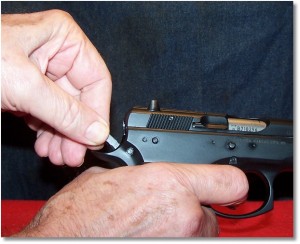
Decking the Pistol For Double-Action Operation Is Done Manually and With Care. Support the Hammer While Pulling The Trigger
Some folks get all up the air about carrying “Condition 1” without considering that “Cocked and Locked” is the way that most pistols these days are carried. Consider the Glock pistol. Once a round is chambered, the only thing that is keeping that round from going out the barrel is keeping your finger off of the trigger and the trigger safety. In some cases, like the Ruger SR series of pistols, an external thumb safety provides an extra measure of safety. The Springfield striker-fired series of pistol utilizes a grip safety and foregoes the thumb safety. Other striker-fired pistol may only utilize a heavy trigger, or other internal safety, to prevent the firearm from discharging until the trigger is pulled.
If the operator wishes to carry with a round chambered, but the hammer lowered (double-action operation), the hammer must be held while the trigger is being pulled. Then, the hammer is slowly lowered. Continuing to to hold the trigger while the hammer is being slowly lowered will result in the hammer being fully lowered. Pulling the trigger, while holding the hammer, and then releasing the trigger as the hammer is being slowly lowered results in the hammer being lowered to a “rest” position, a quarter-cock position if you will. Of course, both of the two methods are performed with the pistol pointed in a safe direction. The CZ 75B Ω (Omega) can be carried safely in either of these two conditions. The pistol is now in double-action mode and the trigger can be pulled at will. Not to worry, due to the hammer block the pistol is very safe to carry in this way. In some cases, the oprator may want to engage the thumb safety to add even a more higher level of safe carry.
Looking at the profile of the pistol, the lines are very pleasant. The slide seems to melt into the frame rather than just sitting on top of it. Looking at the front, one thing that should be there is not – a guide rod bushing. The top of the slide consists of serrations that extend almost the entire slide length and are only interrupted by the sights and the ejection port. This lends not only a nice visual impact to the pistol but also helps to prevent glare in bright sunlight.The grip contour of the pistol is one of the most comfortable that I have ever had in my hand. The grip width, although allowing a staggered magazine of sixteen rounds, feels thinner than that of the Beretta 92FS and the Glock G19 in my hands. Your mileage may vary. The CZ 75B Ω (Omega) feels better (in my hand) than many other pistols. The grip panels are of a rubberized material and provide a more-then-sufficient surface for your shooting paws. The rounded trigger guard helps get the fingers of the shooting hand well tucked in around it while providing a front serrated area on the front of the trigger guard to place the forefinger of the support hand, if that is your style.
The grip panels also afford a nice place to rest the thumb of your shooting hand – just below the thumb safety on the left side. I found that planting the thumb on the rest positioned the web of my hand very nicely under the nicely-shaped beavertail, and the CZ 75B Ω (Omega) has a very nice beavertail that prevents slide or hammer bite. An added plus is that there is no dangling little finger. The bottom of the grip frame sweeps slightly inward and provides a nice platform for the little finger. The sweep of the back strap molds the grip right into the web of the thumb and palm. Even though the CZ 75B Ω (Omega) is a 16+1 machine, the grip width is not that much wider than my Rock Island CS Tactical .45acp with a Hogue rubber wrap-around finger-groove grip. In fact, The Ruger SR1911CMD-A with the Hogue rubber wrap-around finger-groove grip measure about 1.282-inches in thickness; whereas, the CZ 75B Ω (Omega) grip width is about 1.427-inches. There is not enough difference to worry about, to put it plainly.It should be noted that the front and rear of the gripping handle (the frame) is not textured in any way; the back and front straps of the grip frame are smooth. While some may like texturing, I found that it really was not needed.
The trigger is a curved and flat device that welcomes the trigger finger. Trigger reset is quick in single-action mode and when you learn where it is, fast firing the pistol is a relative breeze. For me, and while I don’t have mitts like Hickock45, I found that my best accuracy was obtained by locking the first joint onto the trigger when in single-action mode; this is not uncommon for me with most pistols, however.
The very smooth double-action trigger pull is about 10.5 pounds. The double-action trigger pull is very reminiscent of a good, smooth double-action revolver (think Ruger GP100) and is starting to smooth out with use (it was pretty gritty when I first got the pistol). There is actually a “staging” point when in double-action mode. Like the Ruger GP100 (and some others) there is a point in the triggers action where there appears to be a slight slack. Pulling the trigger further is more like operating in single-action mode. Under normal trigger operation (smooth and continuous pull), the “staging point” is hard to detect. Pulling the trigger slowly at first, the operator will detect the “staging point” about ¾ into the trigger stroke. When this “staging point” is reached, the operator can hold this position to ensure the proper sight picture to target is achieved. Then, a slightly further pull of the trigger drops the hammer. This is a useful feature for target shooters who are not under a time constraint. In defensive mode, and with normal trigger operation, the “staging point’ is easily passed, but is still present if looked for.The single-action trigger pull is consistent at 3.5 (or so) pounds on my particular model. That’s right, 3.5 pounds! This is the primary difference between the CZ 75B and the CZ 75B Ω (Omega) – the trigger. The trigger pull weight on the CZ 75B (in single-action) is about 4.5 pounds, by comparison. The single-action pull exhibits some travel until tension is felt. At that point, the trigger starts to feel more “Glockish”: a little resistance and then the hammer drops. Even with a 3.5-pound trigger pull, there is ample space to “back off” of the trigger if necessary – something that is good to have in a defensive firearm. However, when you place your finger on the trigger you had better be ready to shoot it.
According to CZ:
“Thanks to this disassembly and re-assembly becomes simple matter, which can be performed by anybody without the need for any tools. This consequently substantially simplifies thorough maintenance of handgun. The materials used, forming of parts and their functional interconnection together enhanced durability, operating life and reliability of the new trigger mechanism above practically qualifiable value.”
- Reduction in number of parts
- Enhanced service life and reliability
- Easy assembly and disassembly
- Uncomplicated maintenance
As a side note; the price difference between the CZ 75B and the CZ 75B Ω (Omega) was about a Franklin with the CZ 75B Ω (Omega) being the lesser costing of the two. I thought that strange and so did the salesman, as the CZ 75B Ω (Omega) has the enhanced trigger group. Another difference was that the barrel on the CZ 75B had some sort of finish on it; whereas, the barrel of the CZ 75B Ω (Omega) was natural steel – hammer forged steel. To me, it matters not because I keep my barrels oiled. Comparing the trigger on the 75B and the CZ 75B Ω (Omega), the 75B was a little stiffer and a bit heavier, but it took a lot of going back and forth between the two pistols to determine the difference. Some folks like the 75B better than the CZ 75B Ω (Omega). I liked them both, but only one was chosen and the single-action trigger on the CZ 75B Ω (Omega) was the selling point for me.
One caveat about the CZ 75B Ω (Omega) is the take-down method for cleaning. Although similar to the 1911, the CZ does have a quirk. After insuring that the pistol is safe, the slide is pulled back to an alignment mark that exists on the slide and frame. I found that it is easier to hook the finger of the left hand in the trigger guard, and push the slide back (similar to a “press check”) until the alignment marks are aligned. For my pistol, and the fact that it is new, I have to use a plastic (or wood) handle of a small screwdriver to dislodge the take-down pin outward from the pistol. The reason is that there is a spring on the right side of the frame that serves as a locking mechanism for the take-down pin, more or less. (When disassembling, or assembling the pistol, the take-down pin must overcome this spring tension.) Then, I can simply pull the take-down pin from the frame. Once that is accomplished, the slide is slowly released until no spring pressure can be felt, and then the slide is pulled from the frame. Hopefully, and after using this method, the take-down pin may be able to be removed without using a tool; however, that remains to be seen.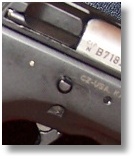
The Take-Down/Slide Lock Pin is Held In Place By Spring Tension and takes a Little Effort to Dislodge
When I fired the pistol for the first time, the target was at ten yards and I was shooting 124-grain FMJ from Georgia Arms. The first two magazines of ammunition revealed that the rounds were impacting slightly right of POA. This is when I found that inserting the shooting finger to the first joint, rather than using the pad of the finger, corrected the issue. Subsequent rounds struck as close to the bulls-eye as close as I could get them. What it does prove is that you must find what works for you and your particular handgun. For me, a true sight picture with 124-grain fodder is at 6 o’clock with this pistol. The pistol is extremely accurate at combat distances and beyond. Felt recoil is straight back into the hand and muzzle flip was negligible with the ammunition that I was shooting. I’ll put ‘self defense’ ammunition through it at the next range outing.
Due to the weight of the pistol, and the nearly 4” barrel, recoil is light and muzzle flip easy to control.
UPDATE 12/29/2015:
I was not satisfied with the LOK grip panels for the CZ75B Ω (Omega); the mounting screws would back out during firing the pistol. I installed the o-rings that were provided with the grip panels, but I felt uncomfortable using them as they gave a false sense of how tight the mounting screws were in the frame. The last thing that you want to do is to over-torque the grip mounting screws as, unlike a 1911-based pistol that has grip screw bushings, the grip mounting screws in the CZ screw directly into the frame – the aluminum frame. If you strip the threads, you will need a competent gunsmith to fix things. I removed the LOK grip panels and re-installed the original plastic grip panels.
While at my range/gun shop I was immediately drawn to a CZ75B in highly-polished stainless steel. However, it was not the pistol that drew me but it was the grip panels. They were nicely checkered rubber. I asked the salesperson if I could look at the CZ. Holding the pistol made me desire the rubber grip panels. The pistol was returned to the disappointed salesman.When I arrived home, I immediately went to the CZ USA website and located the highly polished stainless steel CZ pistol. The rubber grips were standard on this pistol. After locating them in the CZ store, an order was placed and the wait began.
A week later, the new grip panels arrived and the CZ75B Ω (Omega) was pulled from it case. The existing grip panels were removed and the new rubber panels test fitted – that was a good thing because the holes in the grip panel had to be enlarged slightly for the mounting screws and grip panel mounting holes to mate. Luckily, I have a small hand reamer and I know how to use it.
The grip panel mounting holes were reamed slightly so that the mounting screws inserted freely through the panels. Careful is the key word here as the edges of the grip panels must insert into the frame and that takes a little kneading of the panel edges to fully seat the panels. After five minutes or so, the grip panel exchange was made and I was highly satisfied with the feel of the grip on the pistol. The rubber grip panels are finely checkered and provide a non-slip surface. They also look great on the pistol. Note that the left-side grip panel has a thumb rest; something that was not available on the standard grip panels but was an option with the LOK grip panels.
UPDATE 04/07/2016:
After shooting the CZ 75B Ω (Omega) for a bit, I decided (again) to replace the grips. An order was placed to CZ-USA for a set of Cocobolo, partially-checkered grip panels that, I feel, will give the CZ 75B Ω (Omega) a more traditional look (steel and wood) that will augment the inherent beauty of the pistol. I’ll provide an update after installing the new grip panels.
UPDATE 04/14/2016:
I received the set of Cocobolo, partially-checkered grip panels and quickly installed them. I have to say that some pistols just cry out for wood grips and the CZ 75B Ω (Omega) is one of those pistols.
The Cocobolo, partially-checkered grip panels add a touch of class to the CZ 75B Ω (Omega) while adding a slight bit of width to the grip and providing enough texturing in the right places for a good hand hold on the firearm. The contrast between wood and steel has always held a place in my heart.
SUMMING IT UP:
The CZ 75B Ω (Omega) is a fine pistol to hold in the hand. The contour of the grip frame makes it a pleasure to hold and shoot. The pistol itself is a classic piece that may be labeled as ‘old school’ for those lovers of the most modern handguns on earth, but it does what it is supposed to do with class.If you happen to have a range that has a CZ 75B or CZ 75B Ω (Omega) for rent, I advise you not to rent and shoot it. If you do, you may be finding one for your very own. After all, who does not want to shoot a classic?
AUTHOR’S NOTE:
A CZ semi-automatic pistol is also available in .45 acp. It is the CZ 97B (10+1). In addition, the CZ 1911 is a lesser known 1911-based pistol.
The CZ 75B is also available in a “Tactical” version, which means it has a rail.
RESOURCES:
- CZ 75: https://en.wikipedia.org/wiki/CZ_75
- CZ 75B: http://cz-usa.com/product/cz-75-b-9mm-black-16-rd-mags-2/
- CZ 75B Ω (Omega): http://cz-usa.com/product/cz-75-b-%CF%89-omega-9mm-black-16rd-mags/
- Entire CZ 75 Series: http://cz-usa.com/product-category/handguns/75-85-series/
- Excellent IWb Holster: http://www.shtfgear.com/
- Sources for C& 75 magazines: Brownells, Midway, Sportsmans Guide
RELATED VIDEO REVIEWS:
- CZ 75 (HICKOCK45) : https://www.youtube.com/watch?v=WgDhURHa0OQ
- CZ 75 Chapter 2 (HICKOCK45): https://www.youtube.com/watch?v=bbJPdksZfNo
- CZ-75B Omega 9mm Pistol Review (Sootch00): https://www.youtube.com/watch?v=lrBAW-R1teo
![]()


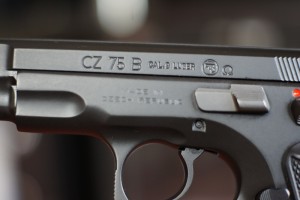
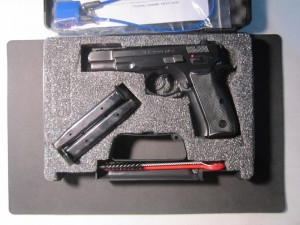
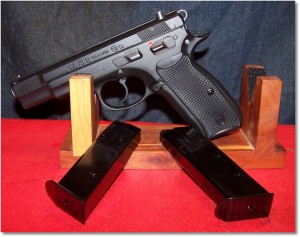
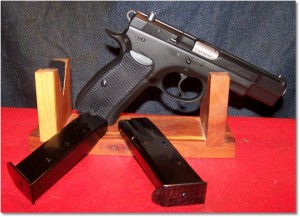
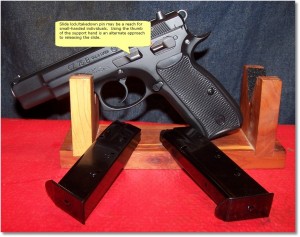



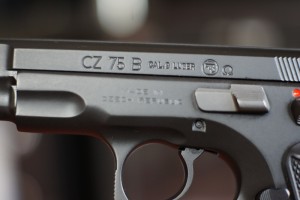
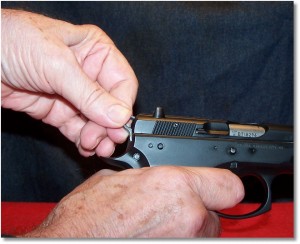


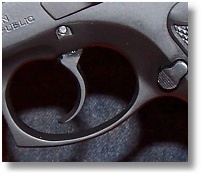
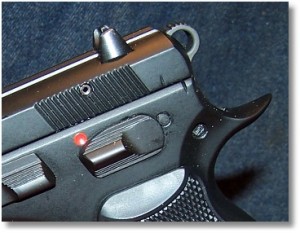
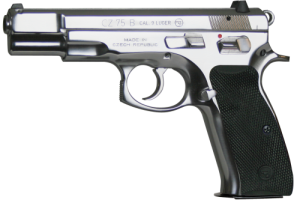

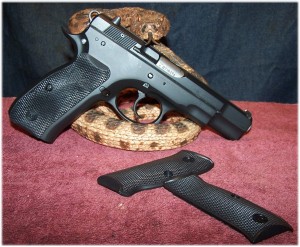
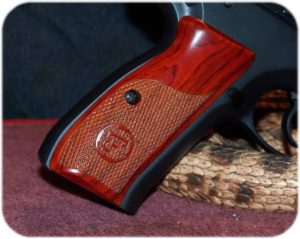
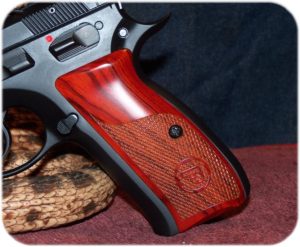
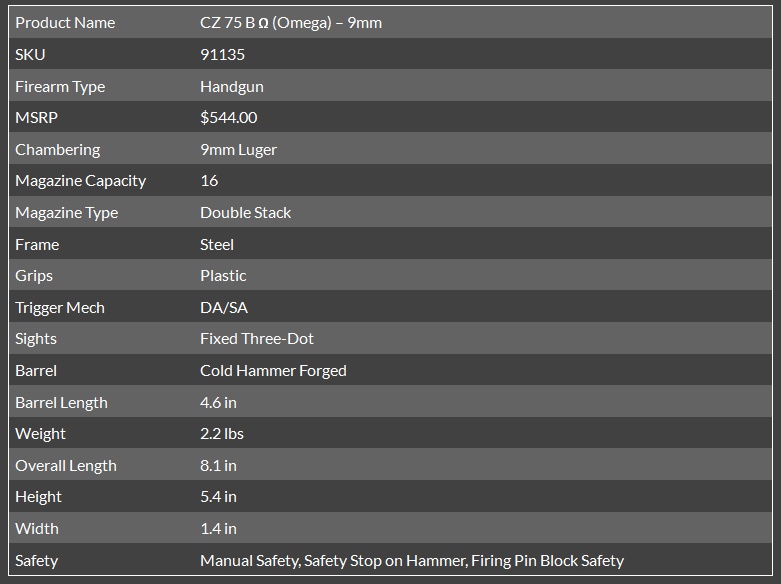
One Response to CZ 75BΩ (Omega) Review